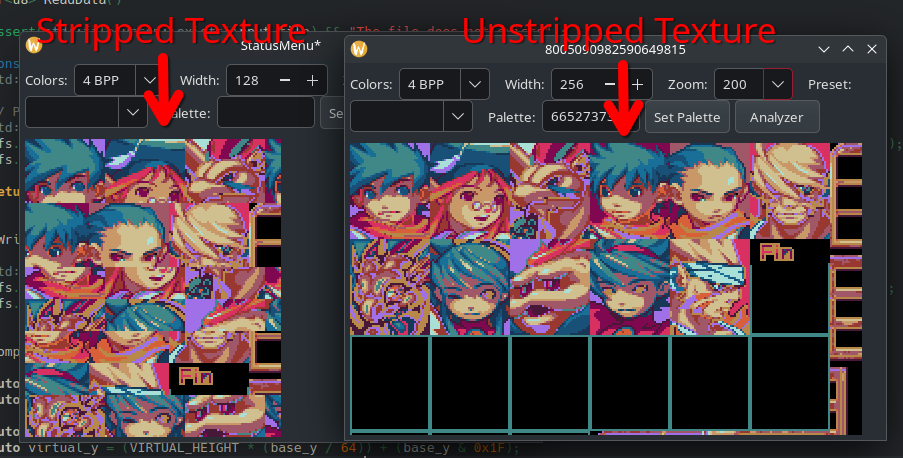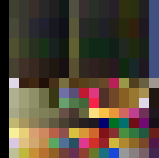Texture and Palette
Table of content:
Introduction
Textures and palettes represent most of the visuals that will appear on screen:
- Characters, monsters, ...
- Texts and menus,
- Textures applied to 3D meshes,
- ...
In this document, we'll look at how these data are encoded and how they relate to each other.
Texture
Textures in the EMI files all seem to have the same Data Type, which is 3.
They have no header, and no information about their width, height, bits per pixel and palette used.
There's only raw texture data.
Information
There are ways of finding this information relatively easily:
- Find out what platform the game is running on (Playstation), and what formats are available on it,
- Use raw image-reading software (such as TileMolester), and change the settings until you find the right format.
To compress textures size, a palette system (also known as CLUT: Color Lookup table) allows you to use only a color index found in a table:
- If an image's pixels are encoded in 4 bits, then the image can contain 16 different colors,
- If an image's pixels are encoded in 8 bits, then the image can contain 256 different colors.
However, in BoF3, two formats in particular stand out:
- For textures encoded in 4 bits per pixel, the width is 128 pixels,
- For textures encoded in 8 bits per pixel, the width is 64 pixels.
Keep in mind that there are other possible formats.
Textures can themselves be split into several tiles, with a size not specified in the data. (This information is probably hardcoded directly when the texture is used)
Now, if you try to visualize a texture with the above information, you'll see elements, but in a “broken” way. This is because the texture is composed of “strips”.
In fact, to see the texture properly, you'll need to glue the strips together correctly:
- A stripe is 256 pixels wide by 32 pixels high,
- This seems to apply to both 4bpp and 8bpp images.

Example stripped and unstripped texture
Here's an algorithm in C++ to perform this transformation from one data array to another of the same size:
u64 ComputeUnstrippedIndex(u64 stripped_index)
{
auto stripped_x = stripped_index % STRIPPED_TEXTURE_WIDTH;
auto stripped_y = stripped_index / STRIPPED_TEXTURE_WIDTH;
auto unstripped_x = stripped_x + ((stripped_y & 0x20) >> 5) * STRIPPED_TEXTURE_WIDTH;
auto unstripped_y = (STRIPE_HEIGHT * stripped_y / 64)) + (stripped_y & 0x1F);
return unstripped_x + unstripped_y * STRIPE_WIDTH;
}
int main()
{
// Read the stripped texture data, and create another array of the same size (initialized to 0)
vector<u8> stripped_texture_data = ReadData();
vector<u8> unstripped_texture_data(input_data.size());
// We compute the index of each "unstripped" pixel, and push it to the output
for(u64 i = 0; i < stripped_texture_data.size(); ++i)
unstripped_texture_data[ComputeUnstrippedIndex(i)] = stripped_texture_data[i];
// Just write the new data in a file, the texture has now a width of 256, with the encoding
WriteData(unstripped_texture_data);
}
Palette
Palettes are used in textures to provide them colors. They are composed by multiple rows of colors. The number of max rows possible in a palette is not defined, yet.
Again, like textures, palettes does not have any header, but you can use the same tools to find their content.

Example of a palette
Most of the time, palettes are not too far from the textures they are used (in the same EMI file), but for a very few of them, they seem to be loaded once (NEED TO BE CONFIRMED WITH MORE RESEARCH).
Generally, when a palette is used:
- In a 4bpp texture: each row of this palette would be composed with 16 colors,
- In a 8bpp texture: NEED MORE INVESTIGATION.
Again, other formats are possible.
Now, each Color of the palette is encoded in 16 bits, (more info on TIM_format):
| RED | GREEN | BLUE | STP* |
|---|---|---|---|
| 0 to 4 (5 bits) | 5 to 9 (5 bits) | 10 to 14 (5bits) | 15 |
The STP is the "Special transparency processing": Because by default, the color Black (r0, g0, b0) is treated as
transparent, unless the STP bit is set to 1.
Now, let's do some code! How to convert those 16 bits color to a more standard 24 bits ?
using u8 = uint8_t;
using u16 = uint16_t;
// A classic 24 bits color
struct ColorRgb
{
u8 r{};
u8 g{};
u8 b{};
};
ColorRgb Convert16BitsTo24Bits(const u16 pixel)
{
// I'm using at least C++20 here (https://en.cppreference.com/w/cpp/language/aggregate_initialization)
// but you can initialize the old fashion way too.
return
{
// ([SBBBBBGGGGGRRRRR] << 3) & 0xF8 = [BBBGGGGGRRRRR000] & [0000000011111000] = [RRRRR000]
.r = static_cast<u8>((pixel << 3) & 0xF8),
// ([SBBBBBGGGGGRRRRR] >> 2) & 0xF8 = [00SBBBBBGGGGGRRR] & [0000000011111000] = [GGGGG000]
.g = static_cast<u8>((pixel >> 2) & 0xF8),
// ([SBBBBBGGGGGRRRRR] >> 7) & 0xF8 = [0000000SBBBBBGGG] & [0000000011111000] = [BBBBB000]
.b = static_cast<u8>((pixel >> 7) & 0xF8)
};
}
You are now the master of colors!
TIPS
Palettes of the games can be found in EMI files by using their
Pointer/RAMvalue of the EMI's table of content:The
Pointer/RAMof palettes should be between 0x80033XXX and 0x8003AXXX.
How palettes are used in textures
From initial research and results, it would appear that for 4BPP textures, a row from the palette is applied
to a tile of a texture: 1 row of 16 colors == Colors of a single tile.
Still needs a lot of investigation on this side.
Todo - Missing elements
- Find where are stored the tiles structure of a texture,
- Find a way to know which palettes are used in a texture,
- Find a way to know which rows in palette is used in a tile,
At the moment, I'm a bit stuck on this part, so I started to investigate another file in STATUS.EMI.